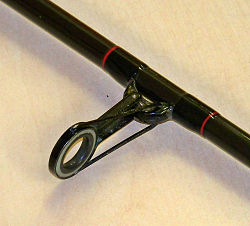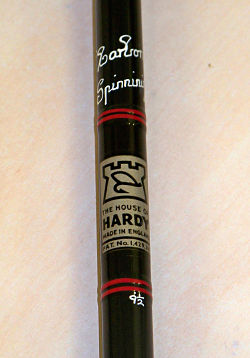The Birth of a Rod
Who would have thought that one of the first items donated to Angling Heritage (UK) would be the world’s first carbon fibre fishing rod, jointly produced by combining the creative talents of Richard Walker (of the Moncrieff Rod Development Company), Leslie Phillips of the Royal Aircraft Establishment (RAE) at Farnborough, and The House of Hardy, Alnwick.
The foundations of the development of carbon rods were laid when Hardy’s employed the services of the Moncrieff Rod Development Company (MRDC) consisting of Leslie Moncrieff, Fred Buller, Richard Walker and Fred J. Taylor to act as consultants in 1964, at a time when materials used in rod making were changing rapidly.
Richard Walker was an engineer, as was Leslie Moncrieff, and both had given advice to much of the tackle trade over the years and were frustrated that much of this advice was subsequently ignored. By performing the role of consultants within the MRDC and selling their expertise, they thought that more attention would be paid to their ideas, and so it proved, working with Hardy’s at a very successful period for the company.
With the structure in place, the spark that ignited carbon fibre rod development was a BBC television programme entitled ‘From Strength to Strength, The Search for New Materials’ broadcast at 21.25 on 2nd June 1964. This programme was arranged by the Ministry of Supply who were seeking to exploit the invention of carbon fibre, a new material developed by RAE Farnborough for use in aerospace, boats and racing cars. It was hoped that there would be other commercial opportunities, and the Ministry offered the inducement of a bundle of twisted fibres (referred to as a tow) 0.9m long free of charge for experiments, provided that the results obtained were shared with the RAE.
Walker, having seen the programme was one of the first to beat a path to Farnborough, taking Jim Hardy with him. This proved to be an enthusiastic meeting of minds, where Leslie Phillips agreed to co-operate in the production of prototype fishing rods made from carbon fibre reinforced plastic in 1968, at a time when Hardy’s were opening their fibatube facility in the factory at Willowburn, one of the largest such facilities in Europe.
As development showed promise, a patent was applied for and patent number GB1351732 was granted jointly in 19th April 1971 to R. Walker, W. Hardy & L. Phillips. This patent applied to a limited carbon content of between 2 and 25% following Walker’s initial calculations (and up to 35% carbon content in the butt section allowing a smaller diameter to be produced).
The first spinning rod (the subject of this article) which was made from this material was manufactured utilising the mandrels used to produce fibreglass rods and proved too stiff, and far more powerful than anticipated. Fred Buller retained the prototype and used it in his cottage in Ireland for pike fishing. It was so powerful that it proved ideal for casting herring or half mackerel deadbaits when pike fishing the Irish loughs and was often used by guests who came to stay with Fred but hadn’t brought the right tackle.
 For over 30 years the rod was well used, and Fred, understanding the historical significance of this first carbon fibre rod, had it restored by Hardy’s at the turn of the millennium. The original handle and reel fitting were renovated and the rings, including a folding butt ring seen on many later Hardy beachcasting rods, were rewhipped retaining as much of the original as possible, but bringing the rod back to an “as new” condition..
For over 30 years the rod was well used, and Fred, understanding the historical significance of this first carbon fibre rod, had it restored by Hardy’s at the turn of the millennium. The original handle and reel fitting were renovated and the rings, including a folding butt ring seen on many later Hardy beachcasting rods, were rewhipped retaining as much of the original as possible, but bringing the rod back to an “as new” condition..
This rod which bears the Hardy logo with a later patent number, 1-429-309 (which relates to carbon fibre reinforced spigot ferrules) has been presented by Fred Buller to Angling Heritage (UK) and is now known as the ‘Carbon Spinning 9.5’. It is interesting to note that the first rods produced by Hardy’s all carried this patent number, rather than the one issued for rods manufactured from carbon fibre.
 Other prototypes were later produced; fly rods were also too powerful, snapping flies from leaders during casting. Later models of rods were manufactured on smaller diameter mandrels made by Hardy’s which helped to reduce the weight further and this also allowed a greater percentage of carbon to be used in manufacture which negated the effectiveness of the patent and allowed Hardy’s competitors free access to this new market sector. Including the carbon content limitations in the patent had rendered it unenforceable. Had this percentage not been limited, Hardy’s would have had a more dominant market position for many years.
Other prototypes were later produced; fly rods were also too powerful, snapping flies from leaders during casting. Later models of rods were manufactured on smaller diameter mandrels made by Hardy’s which helped to reduce the weight further and this also allowed a greater percentage of carbon to be used in manufacture which negated the effectiveness of the patent and allowed Hardy’s competitors free access to this new market sector. Including the carbon content limitations in the patent had rendered it unenforceable. Had this percentage not been limited, Hardy’s would have had a more dominant market position for many years.
The carbon fibre material was also being refined with a less stiff fibre having higher elongation at the break. This new fibre (the Type II), was already being developed within the RAE, and also being manufactured in the form of a thin continuous tow.
Initial attempts to weave the fibre on a small hand loom showed real promise, and a contract was placed with James Carr & Sons Ltd to mechanise production. Early manufacturing problems included cleaning and sizing the fibres and feeding them into the machine on low friction guides. The warp threads had to be held by individually spring-loaded reels otherwise the weave was uneven. Special conductors had to be inbuilt to dissipate the static electricity build-up, and each motor had to be fitted with a plastic shroud using pressurised air flowing outwards from within to prevent fibre “fluff” from shorting out the power.
The resultant tapes, or cloth, were beautifully even, with their flattened carbon warps arranged in a parallel array held together with a light glass weft. This material became known as unidirectional carbon cloth.
The first signs of carbon fibre products being launched by Hardy’s were in carbon reinforced ferrules in 1974 which appeared in the 1975 catalogue, a year before Hardy presented their first rod in the 1976 catalogue.
Hardy’s were quick to point out there that carbon fibre was their development and they didn’t release it into the marketplace until the design of the rod and joints was perfect for their customers. Other manufacturers hastily tried to get the product to the market but experienced production difficulties resulting in unreliable rods, many having hundreds of defective rods returned. It has been written in Barrie Rickard’s book Walker (Medlar Press) that Hardy’s were slow to launch the product fully because they were conservative and didn’t know if the angling market would accept another material, even though Walker was extolling its virtues in his articles the angling press. However, Hardy’s insist that this delay was purely because of their high standards and did not wish to launch an imperfect product.
The market became fiercely competitive, with UK manufacturers launching rods with 80-90% carbon content, and inferior rods were being imported, all marked as carbon fibre but with vast differences in quality before Hardy’s could get established as the premier manufacturer.
However, fibatube rods continued to be the main focus within the Hardy catalogues in the late 1970’s and retained that presence for many years, finally being phased out completely in the 1992 edition.
Using this new material, Walker and Hardy’s developed a superb range of fishing rods, one model bearing the name “Farnborough” in recognition of the collaboration, and it has gone on to become the accepted material for the manufacture of the premier rods of today.